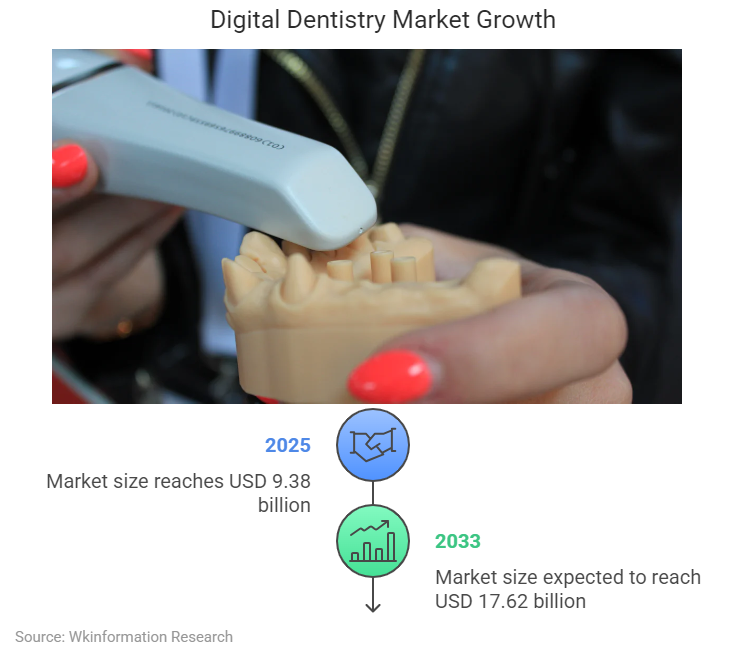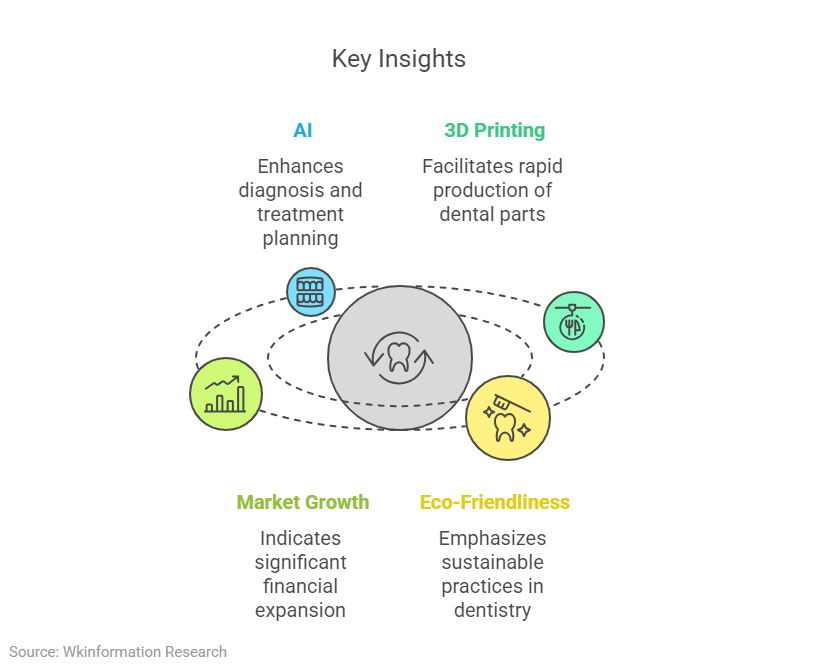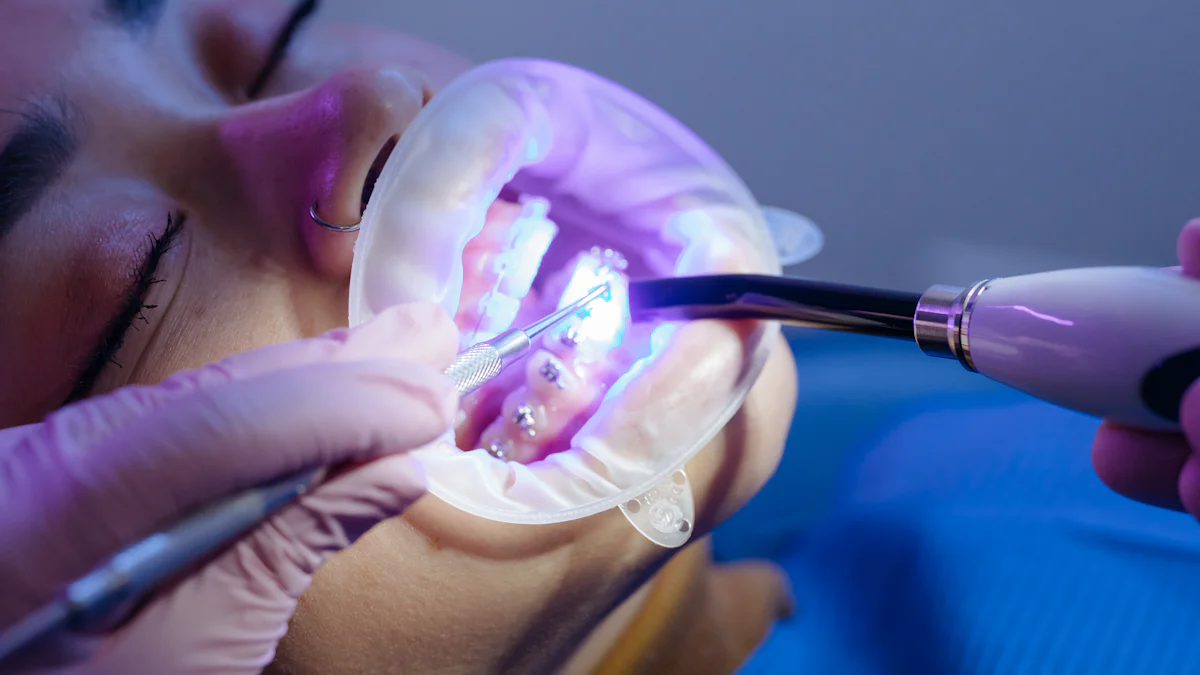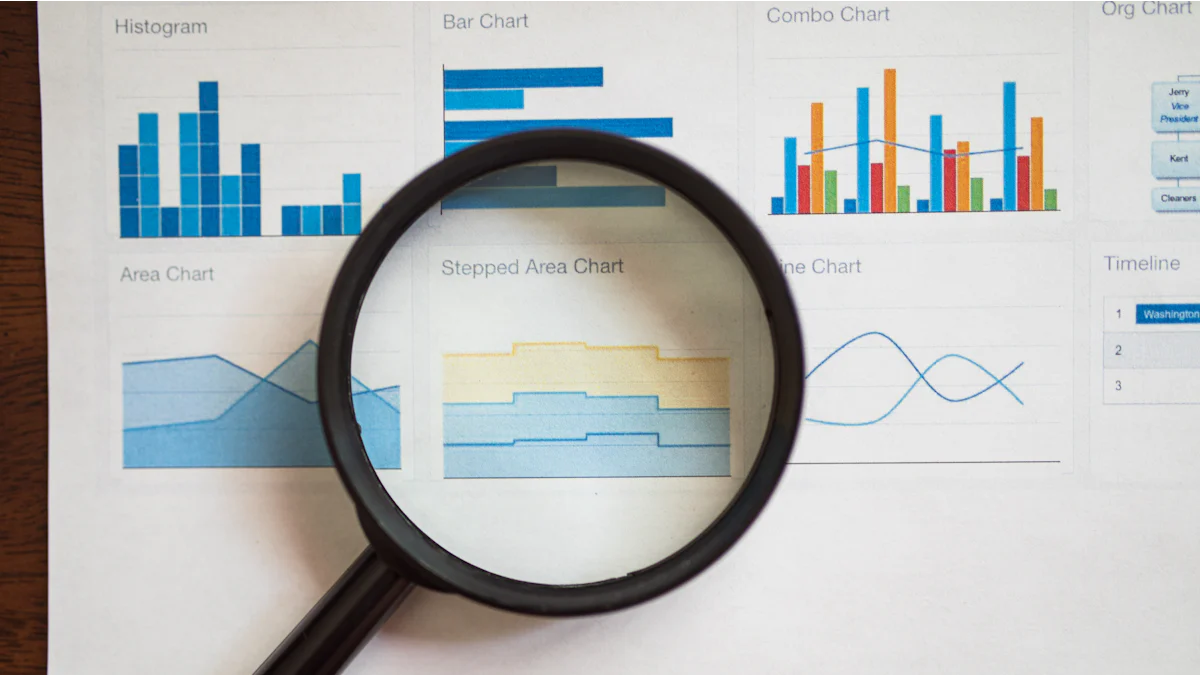
The dental industry has undergone a remarkable transformation with the advent of digital dentistry. This innovative approach leverages cutting-edge technologies to enhance precision, efficiency, and patient outcomes. The market size will reach USD 9.38 billion in 2025 and is expected to reach USD 17.62 billion by 2033, with a CAGR of 8.2% from 2025 to 2033. Key advancements, such as artificial intelligence and 3D printing, have revolutionized diagnostics and treatment planning. AI, for instance, improves diagnostic accuracy by analyzing dental images swiftly, enabling dentists to make informed decisions. These advancements not only streamline workflows but also redefine the future of dental care.
Key Insights
- Digital dentistry is changing dental care with new tech like AI and 3D printing. It helps make treatments more accurate and better for patients.
- The global digital dentistry market is growing fast. It may reach about USD 17.62 billion by 2033 due to new tech and higher demand.
- AI improves diagnosis by quickly studying dental images. This helps dentists find problems early and plan treatments for each patient.
- 3D printing makes custom dental parts quickly. This lowers waiting times and makes patients more comfortable.
- Digital dentistry is focusing on being eco-friendly. Dentists now use green materials and cut waste with digital tools.

Overview of the Digital Dentistry Market
Market Size and Growth Projections
The digital dentistry market is experiencing robust growth, driven by technological advancements and increasing demand for advanced dental care. The market was valued at USD 9.38 billion in 2025 and is projected to grow at a CAGR of 8.2% from 2024 to 2033, forecasting the market to reach US$ 17.62 billion by 2033.
Several factors contribute to this growth. Innovations in dental equipment, such as intraoral scanners and 3D printing, enhance precision and efficiency. The aging population and rising prevalence of dental disorders, affecting over 3.5 billion people globally, further fuel demand. Additionally, cost-effective digital solutions are expanding access to underserved markets, increasing adoption rates.
Market Segmentation by Product Type
Dental Consumables
Dental consumables in digital dentistry include materials used for treatments such as 3D printing resins, digital impression materials, and CAD/CAM blocks. These consumables are designed for high precision and ease of use in various digital workflows. As dental practices shift to more digital methods, demand for these materials is growing due to their ability to enhance treatment accuracy and reduce chair time.
Dental Equipment
Dental equipment in the digital dentistry space encompasses advanced tools such as CAD/CAM systems, intraoral scanners, digital X-ray machines, and 3D printers. These devices enable dental professionals to perform more accurate diagnostics, create detailed treatment plans, and provide faster, more efficient treatments. The rise in digital adoption across dental practices is driving the market for this equipment, even though the initial investment can be significant.
Market Segmentation by Application
Restorative Dentistry
Digital workflows in restorative dentistry simplify procedures like crowns and fillings, improving accuracy and patient satisfaction.
Orthodontics
Technologies like 3D imaging and CBCT enable customized treatment plans and precise appliance designs, revolutionizing orthodontic care.
Implantology
Guided implant surgery, powered by 3D printing and imaging, ensures accurate placement, enhancing success rates.
Cosmetic Dentistry
Digital smile design and CAD/CAM systems have transformed cosmetic dentistry, offering personalized and efficient solutions.
Key Players in the Digital Dentistry Market
Analysis of Major Players Like Dentsply Sirona, Align Technology, and 3Shape
The digital dentistry market features several prominent companies that drive innovation and growth. These industry leaders include Dentsply Sirona, Align Technology, and 3Shape. Each company plays a pivotal role in advancing dental care through cutting-edge technologies.
- Dentsply Sirona leads the market with its comprehensive portfolio of dental equipment and consumables. Its CAD/CAM systems and imaging solutions streamline workflows, enhancing precision and efficiency in dental practices.
- Align Technology, renowned for its Invisalign system, revolutionized orthodontics with clear aligners. The company integrates 3D printing and AI to deliver customized treatment plans, improving patient outcomes.
- 3Shape specializes in digital solutions such as intraoral scanners and software for restorative and orthodontic applications. Its innovative tools empower dentists to provide personalized care with greater accuracy.
Other key players include Straumann Group, Planmeca Oy, and Ivoclar Vivadent AG. These companies contribute to the market by offering advanced products and services that address diverse dental needs.
Emerging Players and Startups Driving Innovation
Emerging players and startups are reshaping the digital dentistry landscape with groundbreaking innovations. They focus on making advanced dental care more accessible and sustainable.
- Many startups develop cost-effective digital solutions, enabling wider adoption in underserved regions.
- The integration of tele-dental platforms facilitates remote consultations and treatment planning, expanding access to care.
- Customized dental services, powered by CAD/CAM systems and 3D printing, enhance patient satisfaction by delivering tailored solutions.
- Advancements in dental education, such as digital simulation tools, improve training for future professionals.
- Green dentistry practices, including eco-friendly materials and processes, reduce the environmental impact of dental procedures.
- AI-powered diagnostics and treatment planning tools improve accuracy and efficiency, transforming patient care.
- Intraoral scanners and laser dentistry gain popularity for their precision and minimally invasive nature.
These innovations highlight the dynamic nature of the digital dentistry market, where established leaders and emerging players collaborate to shape the future of dental care.
Key Trends in Digital Dentistry

Artificial Intelligence (AI) in Dentistry
AI is revolutionizing the digital dentistry market by enhancing diagnostics and treatment planning. AI technologies analyze dental images, such as X-rays and CT scans, with remarkable speed and accuracy. This capability allows dentists to identify early signs of dental issues, enabling prompt interventions. Machine learning algorithms also assist in creating personalized treatment plans by evaluating patient data and historical outcomes. These systems ensure tailored care, improving patient satisfaction and overall outcomes.
Predictive analytics, powered by AI, further elevates patient care. By modeling the progression of dental conditions, AI enables early intervention strategies. For instance, in periodontal disease, AI forecasts potential advancements and recommends preventive measures. Additionally, AI systems provide real-time feedback during ongoing treatments, ensuring alignment with benchmarks and suggesting adjustments when necessary. This approach reduces risks and enhances the likelihood of successful outcomes.
3D Printing and Additive Manufacturing
3D printing has become a cornerstone of personalized digital orthodontics and prosthetics. This technology allows dentists to create highly precise crowns, bridges, and surgical guides tailored to individual patients. The customization improves the fit and effectiveness of dental restorations, enhancing patient comfort and satisfaction. Furthermore, 3D printing accelerates production processes, enabling same-day treatments. Traditional methods often require weeks, but 3D printing produces restorations in-house within hours, reducing patient visits and associated costs.
The cost-effectiveness of 3D printing extends to eliminating the need for external labs. Dentists can streamline workflows and reduce expenses related to shipping and lab fees. This efficiency not only benefits practitioners but also makes advanced dental care more accessible to patients.
Teledentistry and Remote Care
Teledentistry and remote monitoring are transforming how dental care is delivered. In 2023, 30% of dentists reported using teledentistry, with most adopting it within the last three years. Virtual consultations allow patients to receive expert advice without visiting a clinic, making dental care more convenient and accessible. Remote monitoring tools also enable dentists to track treatment progress and ensure compliance.
Wearable devices are increasingly integrated into oral health monitoring. These devices collect real-time data on jaw activity, treatment progress, and patient compliance. This information aids in diagnostics and treatment planning, paving the way for personalized care strategies. Future advancements in wearables may further enhance sustainability by promoting preventive care and reducing the need for invasive procedures.
Sustainability in Digital Dentistry
Eco-friendly Materials and Processes
The digital dentistry market is embracing sustainability by adopting eco-friendly materials and processes. Biodegradable toothbrushes and non-toxic cleaning agents are gaining popularity among dental professionals. These products reduce environmental impact while maintaining high standards of oral care. Many dental practices now prioritize green initiatives, such as using sustainable packaging and sourcing materials responsibly. These efforts align with the growing demand for environmentally conscious healthcare solutions.
Digital radiography exemplifies sustainability in dental practices. Unlike traditional X-rays, digital radiography eliminates the need for chemical processing, reducing hazardous waste. This technology also minimizes radiation exposure, ensuring safer diagnostics for patients. Additionally, the integration of tele-dentistry reduces the carbon footprint associated with patient travel. Virtual consultations and remote monitoring contribute to a more sustainable approach to dental care.
Reducing Waste Through Digital Workflows
Digital workflows in dentistry significantly reduce physical waste. Technologies like CAD/CAM and 3D printing streamline the production of dental restorations, eliminating the need for physical molds and impressions. These methods not only enhance precision but also minimize material wastage. For instance, 3D printing enables the creation of custom dental prosthetics with exact specifications, reducing excess material use.
The adoption of digital solutions extends to orthodontics and other dental treatments. Digital impressions replace traditional plaster models, which often generate considerable waste. By transitioning to digital workflows, dental practices can optimize resource utilization and lower their environmental impact. Furthermore, the use of advanced software for treatment planning reduces the reliance on disposable materials, promoting sustainability in dental care.
The focus on sustainability in digital dentistry reflects a broader commitment to eco-friendly practices. By leveraging innovative technologies and adopting green initiatives, the industry is paving the way for a more sustainable future.
Regional Analysis of the Digital Dentistry Market

North America
North America dominates the global digital dentistry market in 2025. Several factors contribute to this leadership position:
- Advanced healthcare infrastructure supports the adoption of cutting-edge dental technologies.
- Major industry players, such as Align Technology and Dentsply Sirona, are headquartered in the region.
- Strong investment in research and development fosters innovation in dental solutions.
The U.S. leads the region of the market share. High disposable incomes and a preference for advanced products, such as CAD/CAM systems and 3D printing technologies, further fuel demand. Numerous educational resources and training programs also ensure that dental professionals remain adept at utilizing these innovations.
Europe
Europe represents a growing market for digital dentistry, driven by increasing demand for cosmetic procedures and technological advancements. The region has witnessed a surge in the adoption of intraoral scanners, 3D printing, and AI-powered solutions, which enhance diagnostic precision and treatment efficiency. Consumers seek convenience and personalized care, prompting dental practices to integrate these technologies.
Government initiatives play a pivotal role in promoting digital healthcare. For instance, the Digital Europe work programs allocate €762.7 million to digital solutions benefiting citizens and businesses. Additionally, the “Digital Transformation of Health and Care” initiative focuses on secure health data access, personalized medicine, and empowering citizens with digital tools. These efforts create a favorable regulatory environment, accelerating the adoption of digital dentistry across the region.
Asia-Pacific
The Asia-Pacific region is experiencing rapid growth in the digital dentistry market, driven by rising dental tourism and increasing awareness of oral health. Cost-effective yet high-quality dental services attract international patients, while integrated service packages combining dental treatments with wellness experiences enhance the appeal of dental tourism.
The prevalence of dental issues, such as caries and periodontitis, underscores the need for advanced dental care. Surveys indicate that over 90% of adults aged 35 to 74 years suffer from dental caries, while 52.8% of middle-aged adults experience periodontitis. Governments in the region actively promote digital solutions, further boosting market growth. The integration of teleconsultations and digital health records improves diagnosis accuracy and patient care, attracting a broader audience to digital dentistry services.
Rest of the World
Emerging Markets in Latin America and the Middle East
Emerging markets in Latin America and the Middle East present significant opportunities for the expansion of digital dentistry. These regions are witnessing a growing demand for advanced dental care, driven by increasing awareness of oral health and the rising prevalence of dental disorders. Cost-effective digital solutions, such as affordable CAD/CAM systems, 3D printers, and intraoral scanners, are making advanced technologies more accessible to dental practices of all sizes. This affordability reduces financial barriers, enabling underserved markets to adopt innovative tools.
Several factors contribute to the growth potential in these regions:
- CAD/CAM systems streamline the creation of dental restorations, enhancing precision and efficiency.
- Intraoral scanners replace traditional impressions, offering a more comfortable experience for patients.
- Digital X-ray systems provide high-resolution images, improving diagnostic accuracy.
Additionally, collaborations between private and public sectors are fostering advancements in dental care. Governments and organizations are working together to promote digital solutions, ensuring broader access to modern dental technologies. Emerging dental tech companies in these regions are also driving innovation, further accelerating market growth.
Challenges in Infrastructure and Technology Adoption
Despite the opportunities, several challenges hinder the adoption of digital dentistry in Latin America and the Middle East. These obstacles include financial, technical, and regulatory barriers, as outlined below:
| Challenge | Description |
|---|---|
| High cost of equipment and implementation | Significant financial investment is required. |
| Integration challenges with existing systems | Difficulties in merging new technologies. |
| Concerns about data security and privacy | Risks associated with patient data management. |
| Lack of skilled professionals in some regions | Shortage of trained personnel to operate tech. |
| Regulatory barriers and certification requirements | Compliance issues hinder adoption. |
Supply chain bottlenecks further complicate the situation, delaying investments in advanced dental equipment. Fluctuating tariffs, cited by 58% of dental clinics in these regions, add to the financial strain. Addressing these challenges requires strategic investments in infrastructure, training programs for dental professionals, and streamlined regulatory processes. By overcoming these barriers, emerging markets can unlock the full potential of digital dentistry, improving access to high-quality dental care.
Challenges and Opportunities in the Digital Dentistry Market
Challenges
High initial costs of digital dentistry equipment
The adoption of digital dentistry technologies often requires significant upfront investment. Dental practices must allocate substantial funds for equipment such as CAD/CAM systems, 3D printers, and intraoral scanners. These costs, coupled with the need for specialized training, can deter smaller practices from embracing these advancements. Rising overhead expenses and decreasing reimbursements further exacerbate financial pressures.
Several challenges hinder the seamless integration of digital systems:
- Initial investment and training demand considerable resources.
- Complexities in integrating multiple technologies disrupt workflows.
- Dependence on digital systems introduces vulnerabilities in patient care.
- Increasing operational costs strain dental practices.
- Compatibility issues with existing systems complicate adoption.
These barriers highlight the need for cost-effective solutions and streamlined implementation strategies to encourage increased adoption and expansion of digital dentistry.
Limited access to advanced technologies in developing regions
Developing regions face challenges in accessing advanced dental technologies. Limited infrastructure, high costs, and a lack of skilled professionals restrict the availability of digital solutions. Many practices in these areas rely on traditional methods, which can compromise the quality of diagnostics and treatment. Addressing these disparities requires targeted investments in infrastructure and training programs to bridge the gap and improve patient care globally.
Opportunities
Technological advancements reducing costs over time
Innovations in digital dentistry are driving down costs, making advanced technologies more accessible. Dr. Jacob G. Park demonstrates this efficiency by completing procedures with a full chairside CAD/CAM system in under 90 minutes. This approach eliminates the need for outsourcing, reducing expenses for dental practices. As more professionals adopt these systems, economies of scale will further lower costs, enabling broader access to personalized digital orthodontics and customized treatment plans.
Expanding applications of digital dentistry in preventive care
Digital dentistry offers immense potential in preventive care. Technologies like teledentistry and remote monitoring allow dentists to track oral health and intervene early. Wearable devices and AI-powered diagnostics enhance planning and outcomes by identifying issues before they escalate. These advancements not only improve patient care but also reduce the need for invasive treatments, fostering a proactive approach to oral health.
Future Outlook for Digital Dentistry
Evolution of Digital Dentistry
Integration of AI, IoT, and big data for personalized care
The integration of artificial intelligence (AI), the Internet of Things (IoT), and big data is transforming digital dentistry. AI-powered systems analyze dental images and patient data with remarkable precision, enabling early detection of oral health issues. IoT devices, such as wearable oral health trackers, collect real-time data on jaw activity and treatment progress. These technologies allow dentists to create personalized care plans tailored to individual needs, improving patient outcomes. Big data analytics further enhances this process by identifying patterns and trends, enabling predictive insights for preventive care. Together, these advancements are redefining how dental professionals approach diagnostics and treatment.
Expansion of digital workflows in dental practices
Digital workflows are becoming integral to modern dental practices. Technologies like CAD/CAM systems and advanced imaging technologies streamline procedures, reducing time and costs. Digital smile design tools allow dentists to visualize and plan treatments with greater accuracy, enhancing patient satisfaction. The adoption of 3D printing enables same-day restorations, eliminating the need for external labs. These innovations not only improve efficiency but also minimize material waste, aligning with sustainable practices. As more practices embrace digital workflows, the dental industry is poised for significant operational transformation.
Long-Term Market Potential
Projections for market growth beyond 2033
The digital dentistry market is expected to sustain robust growth beyond 2030. Key projections include:
- The market, valued at USD 9.38 billion in 2025, is anticipated to grow at a compound annual growth rate (CAGR) of 8.2% from 2025 to 2033.
- By 2033, the market size is projected to reach USD 17.62 billion.
This growth reflects the increasing adoption of digital solutions and the rising demand for advanced dental care globally.
Emerging trends and innovations shaping the future
Several emerging trends are set to shape the future of digital dentistry:
- Increased access to care through teledentistry and remote monitoring.
- Time and cost savings for patients and practitioners.
- Early detection and prevention of dental issues via remote consultations.
- Enhanced patient engagement through regular communication with dental professionals.
- Expanded practice reach, attracting a broader patient base.
These innovations, combined with the continuous evolution of digital workflows, will drive the industry toward a more efficient and patient-centric future.
Overview
Digital dentistry continues to redefine the dental industry by integrating advanced technologies that enhance precision, efficiency, and patient care. Key trends, such as AI-powered diagnostics, 3D printing, and teledentistry, are driving innovation and expanding access to care. Despite challenges like high initial costs and limited access in developing regions, opportunities abound through cost reductions and preventive applications. Staying informed about these advancements enables dental professionals and stakeholders to adapt effectively, ensuring they remain competitive in a rapidly evolving market. The future of dentistry lies in embracing these transformative innovations.
| Report Metric | Details |
|---|---|
| Report Name | Global Digital Dentistry Market Report |
| Base Year | 2024 |
| Segment by Type | · Dental Consumables
· Dental Equipment |
| Segment by Application | · Restorative Dentistry
· Orthodontics · Implantology · Cosmetic Dentistry |
| Geographies Covered | · North America (United States, Canada)
· Europe (Germany, France, UK, Italy, Russia) · Asia-Pacific (China, Japan, South Korea, Taiwan) · Southeast Asia (India) · Latin America (Mexico, Brazil) |
| Forecast units | USD million in value |
| Report coverage | Revenue and volume forecast, company share, competitive landscape, growth factors and trends |
FAQ
What is digital dentistry, and why is it important?
Digital dentistry refers to the use of advanced technologies like CAD/CAM systems, 3D printing, and AI in dental care. It improves precision, efficiency, and patient outcomes by streamlining workflows and enabling personalized treatments. This innovation transforms traditional practices, making dental care more accessible and effective.
How does 3D printing benefit dental practices?
3D printing allows dentists to create customized prosthetics, crowns, and surgical guides with high precision. It reduces production time, eliminates the need for external labs, and minimizes material waste. These benefits enhance patient satisfaction and lower costs for dental practices.
What challenges do developing regions face in adopting digital dentistry?
Developing regions encounter barriers like high equipment costs, limited infrastructure, and a shortage of trained professionals. These challenges restrict access to advanced technologies, making it difficult for dental practices to adopt digital solutions. Addressing these issues requires investments in training and infrastructure.
How does AI improve dental care?
AI enhances diagnostics by analyzing dental images with speed and accuracy. It assists in treatment planning by evaluating patient data and predicting outcomes. This technology enables early detection of dental issues, personalized care, and improved patient satisfaction.
What role does sustainability play in digital dentistry?
Sustainability in digital dentistry involves using eco-friendly materials, reducing waste through digital workflows, and adopting green practices. Technologies like digital radiography and tele-dentistry minimize environmental impact while maintaining high standards of care. These efforts align with the growing demand for sustainable healthcare solutions.
Global Digital Dentistry Market Report – Table of Contents
1 Market Study Overview
2 Basic Product Information
3 Market Analysis
4 Digital Dentistry Related Market Analysis
5 Global Trend Summary
6 Competition by Manufacturer
7 Analysis of Key Players
8 Global Digital Dentistry Revenue, Sales Categorized by Regions
9 North America Digital Dentistry Market Size Categorized by Countries
10 Europe Digital Dentistry Market Size Categorized by Countries
11 Asia-pacific Digital Dentistry Market Size Categorized by Countries
12 South America Digital Dentistry Market Size Categorized by Countries
13 Middle East and Africa Digital Dentistry Market Size Categorized by Countries
14 Global Digital Dentistry Industry Segment Analysis
15 Global Digital Dentistry Market Forecast
16 Research Findings and Conclusion
17 Appendix





